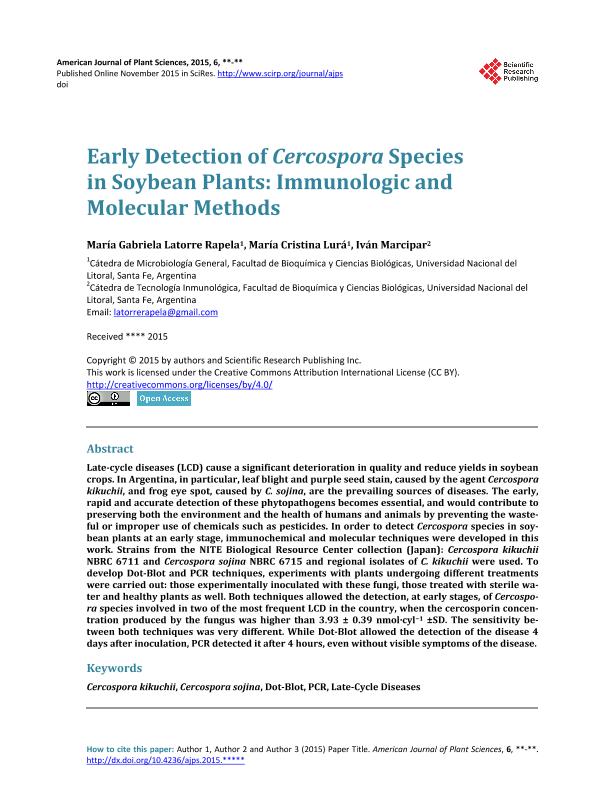Artículo
Early Detection of Cercospora Species in Soybean Plants: Immunologic and Molecular Methods
Latorre Rapela, María Gabriela de Los Milagros; Lura, Maria Cristina Enriqueta; Marcipar, Iván Sergio

Fecha de publicación:
11/2015
Editorial:
Scientific Research Publishing
Revista:
American Journal of Plant Sciences
ISSN:
2158-2742
e-ISSN:
2158-2750
Idioma:
Inglés
Tipo de recurso:
Artículo publicado
Clasificación temática:
Resumen
Late-cycle diseases (LCD) cause a significant deterioration in quality and reduce yields in soybean crops. In Argentina, in particular, leaf blight and purple seed stain, caused by the agent Cercospora kikuchii, and frog eye spot, caused by C. sojina, are the prevailing sources of diseases. The early,rapid and accurate detection of these phytopathogens becomes essential, and would contribute to preserving both the environment and the health of humans and animals by preventing the wasteful or improper use of chemicals such as pesticides. In order to detect Cercospora species in soybean plants at an early stage, immunochemical and molecular techniques were developed in this work. Strains from the NITE Biological Resource Center collection (Japan): Cercospora kikuchii NBRC 6711 and Cercospora sojina NBRC 6715 and regional isolates of C. kikuchii were used. To develop Dot-Blot and PCR techniques, experiments with plants undergoing different treatmentswere carried out: those experimentally inoculated with these fungi, those treated with sterile water and healthy plants as well. Both techniques allowed the detection, at early stages, of Cercospora species involved in two of the most frequent LCD in the country, when the cercosporin concentration produced by the fungus was higher than 3.93 ± 0.39 nmol∙cyl−1 ±SD. The sensitivity between both techniques was very different. While Dot-Blot allowed the detection of the disease 4 days after inoculation, PCR detected it after 4 hours, even without visible symptoms of the disease.
Palabras clave:
Cercospora Kikuchii
,
Cercospora Sojina
,
Dot-Blot
,
Pcr
Archivos asociados
Licencia
Identificadores
Colecciones
Articulos(CCT - SANTA FE)
Articulos de CTRO.CIENTIFICO TECNOL.CONICET - SANTA FE
Articulos de CTRO.CIENTIFICO TECNOL.CONICET - SANTA FE
Citación
Latorre Rapela, María Gabriela de Los Milagros; Lura, Maria Cristina Enriqueta; Marcipar, Iván Sergio; Early Detection of Cercospora Species in Soybean Plants: Immunologic and Molecular Methods; Scientific Research Publishing; American Journal of Plant Sciences; 6; 18; 11-2015; 2939-2948
Compartir
Altmétricas



